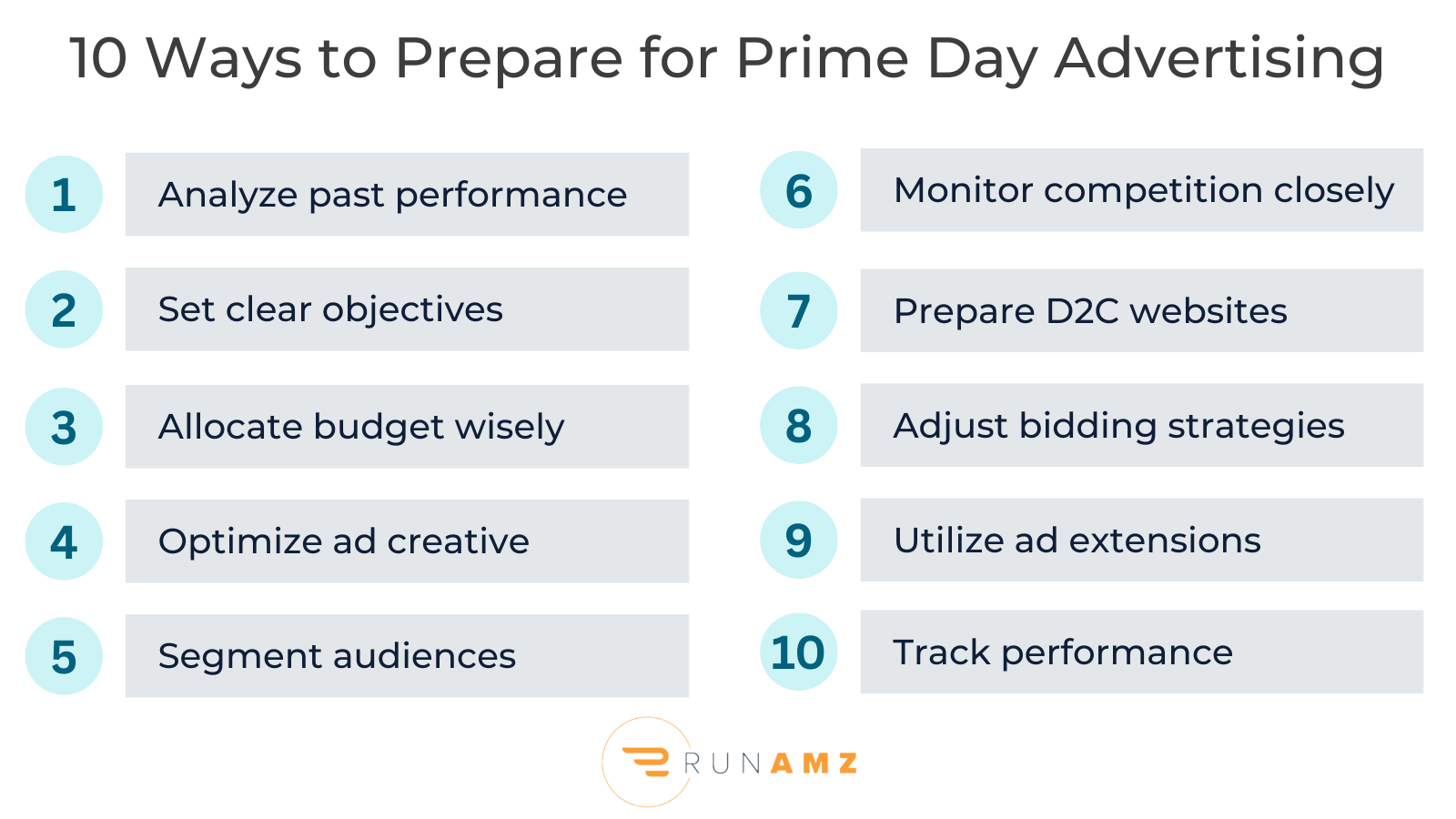Participating in Amazon Prime Day is a massive opportunity for ecommerce brands. However, planning for Prime Day advertising and budgeting requires a strategic approach due to the event’s unpredictability. We know Prime Day usually means huge potential surges in traffic and CPCs (cost per click), but often it isn’t until the few weeks leading up to or even at the start of the tentpole event that brands know what level of competition to expect.
In this article, we’re going to dive into 10 best practices Amazon sellers should do leading up to Prime Day 2024. Here are 10 Prime Day 2024 must-dos in order to maximize visibility and sales:
- Analyze past performance
- Set clear objectives
- Allocate budget wisely
- Optimize ad creative
- Segment audiences
- Monitor competition closely
- Prepare D2C websites
- Adjust bidding strategies
- Utilize ad extensions
- Track performance
Keep reading to dive into the details of each action item and specific things to watch out for.

- Analyze Past Performance
Review past Prime Day performance data if it’s available. Specifically look at traffic spikes, conversion rates, and CPCs from previous Prime Day events to understand trends and patterns.
Note that there is not much value from analyzing the performance of any other previous Amazon tentpole events, such as Turkey 5 or Prime Big Deal Days, as historical CPCs are typically only going to be the same during Prime Day.
2. Set Clear Objectives
Determine brand goals for Prime Day. These could be increasing sales, driving traffic to an ecommerce website, or boosting brand awareness. Once goals are set, make sure to align Prime Day advertising strategies and budget according to the overall objectives.
3. Allocate Budget Wisely
Allocate a sufficient budget for Prime Day advertising campaigns, considering potential increases in CPCs and the overall competitive landscape. Be prepared to invest more than usual to stand out among competitors and capture the attention of shoppers. We typically recommend brands spend 3-5x the normal daily advertising budget during Prime Day.
4. Optimize Ad Creative
Create compelling ad creatives tailored specifically for Prime Day that highlight exclusive deals, discounts, and promotions. Use attention-grabbing visuals and persuasive copy to entice shoppers and drive clicks & conversions.
5. Segment Audiences
Segment the brand’s target audience based on demographics, interests, and past shopping behavior. Tailor ad messaging and offers to these different audience segments to maximize the relevance and effectiveness of Prime Day campaigns.
Note that segmentation strategies may vary from one category to the next. For example, a retargeting strategy works well for CPG brands but wouldn’t necessarily make sense for Sports & Outdoor brands. To determine the right segmentation strategy, consider how often consumers purchase the product(s) and what motivations or incentives encourage them to convert.
6. Monitor Competition Closely
Keep a close eye on competitors’ advertising strategies and promotions leading up to Prime Day. Adjust tactics accordingly to differentiate and stay competitive.
One of the best ways we monitor our brand partners’ competitors is with the Pacvue Share of Voice and Share of Shelf trackers. Watching these metrics allows us to efficiently optimize bids where needed, capturing customers over our brand partners’ competitors.

7. Prepare D2C Website
Expect a surge in D2C website traffic during Prime Day. Often traffic on Amazon drives additional traffic to D2C websites as consumers research products before an Amazon purchase. This is especially true for more expensive durable goods.
Ensure the D2C website is prepared to handle an increased load capacity. Optimize site performance and user experience to prevent crashes or slowdowns, and maximize conversions.
8. Adjust Bidding Strategies
Be prepared to adjust bidding strategies in real-time based on changes in competitor and performance metrics. Monitor CPCs closely and adjust bids to maintain visibility and ROI.
9. Utilize Ad Extensions
Take advantage of ad extensions such as promotions, sitelinks, and callouts to enhance ad visibility and communicate key selling points effectively. Also utilize campaign diversification to drive visibility to Prime Day promotions, using every lever to a brand’s advantage.
10. Track Performance
Monitor the performance of Prime Day campaigns closely in real-time. Track key metrics such as clicks, conversions, and ROAS (Return on Ad Spend). Analyze the data to identify what’s working well and where adjustments are needed. Again, make those adjustments in real-time to maximize campaign effectiveness.
Conclusion
We’ve covered 10 best practices brands should utilize in the lead up and duration of Prime Day 2024 to ensure maximum visibility and sales. By following these strategies and staying agile, brands can effectively plan for Prime Day ads and budgeting, navigate the unpredictability of the event, and capitalize on the opportunities it offers.
